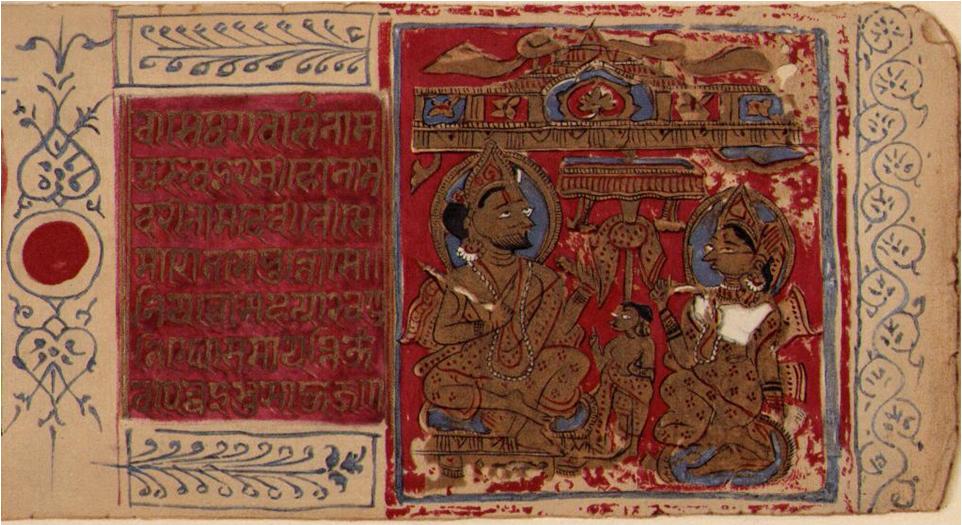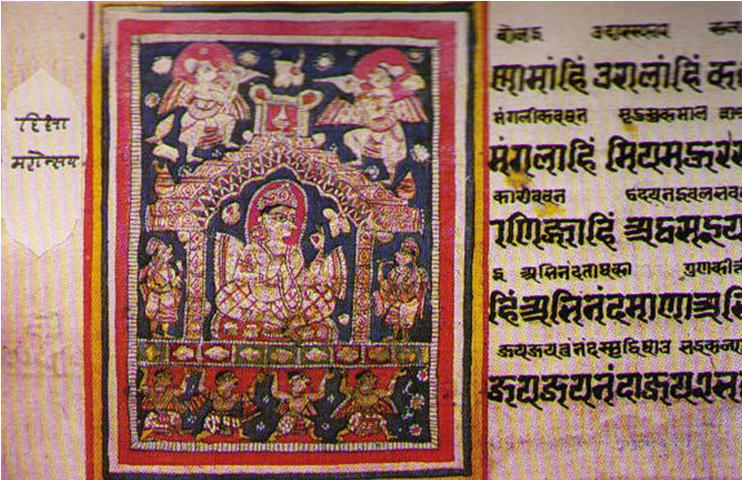The essay was published in January issue of the Journal Calcutta Review, Calcutta University, 1934. For the online reissue some pictures of Jaina miniature paintings were added to illustrate medieavel court life according to Jaina sources.
The Jaina Canon and Early Indian-Court Life
From the canonical writings of a religion one is prepared to gain insight into its dogma, ethics, philosophical ideas, and the history of its propagation and propagators. The last topic may allow glances at its historical and cultural background. Scarcely, however, should one expect to glean from them a harvest of the most vivid descriptions of ancient Indian court life. Still this is one of the pleasant surprises with which the student of the Jaina Agamas is rewarded for the pains it cost him to work through the difficulties of their strange medium, the old Ardha-māgadhī tongue.
All the great Jaina sages were scions of illustrious Ksatriya clans, and all of them were prompted by the voice of religious intuition to leave the vain splendours of a royal court for the loneliness of Sarhnyāsa. This has given the chronicles ample opportunity of enlivening their narrative by dwelling on the contrast between both aspects of the lives of their saints.
So they allow us glimpses of the palace of an ancient king with its sweet-scented, gem-inlaid apartments. We are allowed to peep right into the gaily-painted, mosaic-floored, jewel-lit bedroom of the queen, with its curious toilet requisites. There she reclines on a couch that is smooth like Ganges sand, soft like flakes of cottonwool, covered with cushions and with coverlets of red silk, perfumed with frankincense and olibanum, and strewn with fragrant flowers. Auspicious dreams descend and awake her long before dawn, and we see her rise and leave the room to narrate them to her royal husband, while they are fresh in her memory.

Illustration of court life from a Kālakācāryakathā manuscript, showing prince Kālaka asking his parents for permission to renounce the world (c. 15th century CE, Gujarat/Rajsathan)
Another time we are permitted to watch the king with his gaudy train of followers moving in stately procession through the bazars to the quiet temple garden which the spiritual teacher has chosen for his abode. There we see him dismount from his elephant, leave his retinue behind, as well as sword, parasol, diadem, shoes and chowries, the five emblems of dignity and power, to greet the Guru in all humility. We see him take his seat in the assembly and attentively listen to the sermon, till its last words have died away. Then he draws nearer and engages the Guru in an animated discussion regarding the secrets of life and death, heaven and hell.
At another occasion, the chronicler invites us to watch the queen at her preparations for Pūjā. Workmen are sent to the temple to erect a flower-shamiana, and decorate it with gay patterns representing swans and peacocks, koyals and cranes, gazelles and horses, bears and wolves, and other birds and beasts, all beautifully inlaid in flower-mosaic. Water is sprinkled on the streets leading to the temple, and the bazars are swept and tidied by her orders. At last she leaves her apartments, refreshed from her bath, sumptuously dressed and adorned, mounts her chariot, and drives to the lotus-lake. There she wades into the water, has another ablution, gathers the most perfect of the lotus-flowers with her own hand, and takes them with her to the temple, followed by crowds of slave-girls, who carry flower-baskets and censors. With her own hand too she washes, decorates and worships the idol, as it is customary with her family, and then waits for the arrival of the king.
Another time, the princess may be watched celebrating some auspicious festival. On a little stool she sits, under a specially erected shamiana of the loveliest flowers, in the very centre of a skilful design of the town with all its streets and lanes, outlined on the floor in grains of multi-coloured rice. Presently, she has to submit to a shower-bath poured over her by slave-girls from pitchers of silver and gold. Then she is dressed and decked and led to her royal father, at whose feet she bows, and who places, her in his lap, asking the prime-minister with paternal pride whether he ever saw such a beauty of a little princess before.
With even greater pride may he be seen some other time, listening to the announcement of the birth of a son, and distributing gifts with lavish liberality. We hear him order his officials to release all prisoners, to sprinkle the whole town with scented water, sweep and plaster the streets, and decorate them with arches and banners, to erect shamianas so that the populace may watch the joyous celebrations, to whitewash all the buildings, cover their walls with auspicious hand-prints of sandal-paste, garland them with flowers, strew flowers everywhere, and perfume the air with frankincense and olibanum. Then musicians and singers, dancers and acrobats, wrestlers and jesters, all are ordered to display their art, the populace is to be free from taxes, and there is to be rejoicing and happiness everywhere. Thus he celebrates the event for ten days, and goes about wearing his costliest robes and most precious ornaments.

A subordinate is received in audience by the king (c. 15th century CE)
Again, a royal person may be watched negotiating with the masters of the guild of goldsmiths, who receive orders of the strangest import. Painters are instructed to decorate the walls of some private room with representations of dallying beauties and love-scenes. Wealthy merchants, coming from far over the sea, full of accounts of strange adventures, are received in audience, and curious and valuable gifts graciously accepted. More than once may we see the skilful and successful lavishly rewarded, the unskilled scorned and punished with exile at the hands of a discriminating and high-spirited ruler, the sphere of whose interests seems to have no bournes. On the battle-field too we may watch him, clearly distinguish his curiously equipped army, gaze on old-fashioned weapons, that might well have served as models to the painters of Ajantā and wonder at the stratagems of ancient warfare.
Apart from all such occasional glimpses, we even learn in detail how a king of antiquity begins his day and starts the series of his various activities. The small hours of the morning find him on his bed, peacefully slumbering. Only when the sun comes forth, red like the Aśoka blossom, he rises and straight away begins a good round of hearty bodily gymnastics. He repairs to his gymnasium, and engages, in several bouts of wrestling and boxing, followed by massage, till he feels pleasantly exhausted, and expert masseurs have to dispel his fatigue by rubbing him with refreshing, fragrant ointments, skilfully concocted from innumerable costly ingredients.
Then he enters the bagnio. Under the bath pavilion, the floor of which is a many-coloured mosaic of gems, and the window-grating set with glimmering pearls, stands the jewel-decorated bath-stool. There he takes his seat, to enjoy a hot shower-bath of fragrant, crystal-clear water, goes through a series of auspicious rites, dries his body with a beautiful, soft towel, and dresses in the typical two-piece garment of purest archaic style, made of richest material. Delightful sandal-paste covers his limbs, a garland of sweet-scented flowers in all the five colours adorns his breast, and the resplendent ornaments that deck him all over, glistening on his neck and chest, on his waist, his arms, his wrists and fingers, his ears and forehead, so that he looks like a walking wish-tree, are of so many shapes and varieties that their names and descriptions fill more than a page of the narrative. Thus adorned, he leaves his apartments moving under an amaranth-garlanded parasol, fanned with white chowries, hailed by victory-greetings, and accompanied by his splendid court, from the wise prime minister and his proud Sardars down to the dwarf and jester.
The procession moves to the Darbar hall, where the king holds his levee. On this particular occasion, he intends to consult with the astrologers of the town.Sitting down on the throne, he orders eight seats of honour to be arranged, spread with white cloth, and strewn with auspicious white rape-seed and Dūrvā grass. Then he remembers that his consort will probably be interested in the proceedings, and arranges for her accommodation too. Part of the room is cut-off from the public gaze by a gem-embroidered, gorgeous curtain of exquisite material, that falls in heavy folds to the ground, and shows hundreds of patterns representing wolves, steers, horses, crocodiles, birds, snakes, men, kinnaras, insects, cows, elephants, woodland creepers and lotus-plants. Behind this delightful curtain, a jewel-inlaid seat is placed, and covered with a soft mattress, over which a white cloth is spread.

Depiction of a royal palanquin, carried by four servants. The scene depicts Mahāvīra leaving the palace of his parents to renounce the world (Kalpasūtra manuscript, c. 1600-1625 CE, Gujarat/Rajasthan)
After having supervised these preparations with his own eyes, the king sends for the eight chief astrologers, each of whom represents a different branch of the complicated and advanced art of ancient astrology. Having taken their bath and performed their morning rites, dressed in plain, but spotlessly clean garments, adorned with a few good ornaments of value, and carrying with them as purifiers and emblems of good augury, white rape-seed and Dūrvā grass, they appear in the Darbar hall, and hail the king with the greeting of victory. The king receives them with great respect, and they take their seats on the eight places of honour.
Only after all these preliminaries are gone through and the whole scene has arranged itself, gay with colours, graceful, and yet solemn, like an Ajantā fresco, the king sends word to the queen, inviting her to witness the consultation. She responds at once, quietly takes her place behind the curtain, and listens to the eager questions of the king and the assured answers of the wise men, till at the end they are reverentially dismissed with gifts of all varieties of eatables, flowers, garments, perfumes, ornaments and means of sustenance that will last them all their lives. Then the king shows himself behind the Bordah to talk the event over with his consort, till she finds it the proper moment to take her leave, and retires, walking with the dignified and graceful gait of the Rājaharhsa, to her own apartments.
The canonical writings of the Śvetāmbara Jainas, from which the above gleanings have been taken, are said to go back, in their original shape, to the apostles of Vardhamāna Mahāvīra, whose Nirvana took place in 527 B.C. Still, Jaina tradition itself admits that they have undergone various transformations, and that the definite form in which they are extant to-day, was fixed at the synod of Valabhī in Vīra Nirvana Samvat 980 (according to another view 993), that means 453 A.D. Therefore, the bulk of this literature is at least about 1500 years old. This fact renders the interesting information it supplies concerning obsolete customs and institutions, so valuable and important.
So it is well worth noting that it contains, amongst other invaluable material, the above instance of a pre-Mohammedan Purdah scene, proving that Purdah was a well-established custom with the gallant Ksatriya clans of the Bhāratavarsa of the time. It is surprising that this literature should not have been turned to better account by historians and other students of Indian culture in tracing back and explaining many of the astonishing institutions of this unique country, that has rightly been called a museum of the most fascinating antiquities.
 Dr. Charlotte Krause
Dr. Charlotte Krause